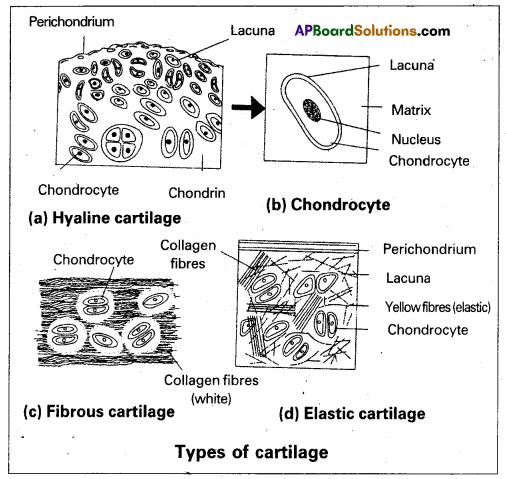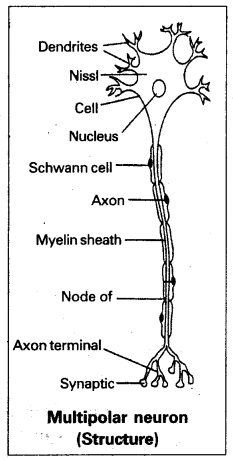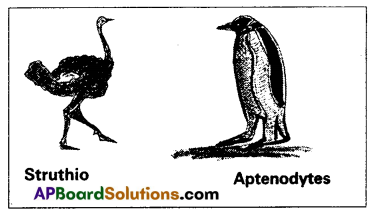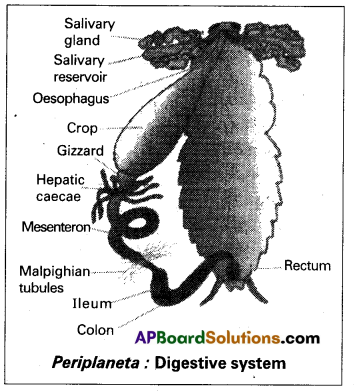Varied difficulty levels in TS Inter 1st Year Zoology Model Papers and TS Inter 1st Year Zoology Question Paper March 2018 cater to students with diverse academic strengths and challenges.
TS Inter 1st Year Zoology Question Paper March 2018
Time: 3 Hours
Max. Marks: 60
Note: Read the following instructions carefully:
- Answer all the questions in Section – A. Answer any six questions in Section – B and answer any two questions in Section – C.
- In Section – A, questions from Sr. Nos. 1 to 10 are of Very Short Answer Type. Each question carries two marks. Every answer may be Limited to 5 Lines. Answer all these questions at one place in the same order.
- In Section – B, questions from Sr. Nos. 11 to 18 are of Short Answer Type. Each question cames four marks. Every answer may be limited to 20 lines.
- In Section – C, questions from Sr. Nos. 19 to 21 are Long Answer Type. Each question carries eight marks. Every answer may be limited to 60 lines.
- Draw labelled diagrams wherever necessary for questions in Section – B and C.
Section – A
10 x 2 = 20
Note: Answer all questions in 5 lines each.
Question 1.
Differentiate between Protostomia and Deuterostomia.
Answer:
Protostomia (Gr. mouth first) are the organisms in which blastopore develops into mouth. Deuterostomia (Gr. second mouth) are the organisms in which blastopore develops into anus, mouth is formed later.
Question 2.
What is sesamoid bone? Give two examples.
Answer:
Sesamoid bones are formed by ossification in tendons. Eg: Patella (Knee cap) and Pisiform bone of the wrist of a mammal.
Question 3.
Which Arthropod, you have studied is called a living fossil? Name Its respiratory organs.
Answer:
The arthropod animal Limulus is called a living fossil, it is respiratory organs are ‘book – gills.
![]()
Question 4.
Write four salient features of cyclostomes.
Answer:
- Cyclostomes are jawless aquatic forms.
- Body is scaleless, long, slender and eel-like in shape.
- The endoskeleton is cartilaginous.
- Vertebrae are represented by imperfect neural arches in some.
- Mouth is circular and suctorial. Hence there are called as Cyclostomes. Ex: Petromyzon.
Question 5.
List any two differences between a flagellum and a cilium.
Answer:
| Flagellum | Cilium |
| 1. Flagellum helps in locomotion only. | 1. Cilium helps in locomotion, feeding and acts as sensory structures. |
| 2. Flagellum produce undular movement. | 2. Cilium produce pendular movement. |
| 3. Flagellum is about 150 m in length. | 3. Chum small in size 5-10 µ in length. |
Question 6.
Define conjugation with reference to ciliates. Give two examples.
Answer:
Conjugation is a temporary union between two senile ciliates that belong to two different ‘mating types for the exchange of nuclear material and its reorganization. – Wichterman. Ex: Paramecium and Vorticella.
Question 7.
The eggs of Ascaris are called ‘mammilated eggs’. Justify.
Answer:
Each egg of Ascaris is surrounded by a protein coat with rippled surface. Hence the eggs of Ascaris are called “mammillated eggs”.
Question 8.
What are frichomes? Write their functions.
Answer:
Trichomes are small hair-like structures of spiracles. Function: Filtering the dust particles.
Question 9.
What is ‘storage excretion’?
Answer:
Urate cells present in the fat bodies absorb and store uric acid through out the life. This is called ‘storage excretion”.
Question 10.
What is an ecosystem?
Answer:
‘An ecosystem is a functional unit of the biosphere in which members of the community interact among themselves and with the surrounding environment.
Section – B
6 x 4 = 24
Note: Answer any SIX questions in 20 lines each.
Question 11.
What are the reasons for greater biodiversity in the tropics?
Answer:
Reasons for greater biodiversity In the tropics:
Reason 1: Tropical latitudes have remained relatively undisturbed for millions of years and thus had a long ‘evolutionary time’. As long duration was available in this region for speciation, it led to the species diversification. (Note: The temperate regions were subjected to frequent gradations in the past).
Reason 2: Tropical climates are relatively more constant and predictable than of,the temperate regions. Constant environment promotes niche specialization (how an organism responds, behaves with environment and with other organisms of its biotic community) and this leads to greater species diversity.
Reason 3: Solar energy, resources like water, etc., are available in abundance in this region. They contribute to higher. productivity in terms of food production. leading to greater diversity.
Question 12.
Describe the three types of the cartilage.
Answer:
Cartilage is a solid, but semi-rigid (flexible) connective tissue. Cartilage iš of three types, which differ form each other chiefly In the composition of the matrix.
Cartilage is a solid, but semi-rigid (flexible) connective tissue. It resists compression. Matrix is firm, but somewhat pliable. It has collagen fibres, elastic fibres (only in the elastic cartilage) and matrix-secreting cells called chondroblasts.
These cells are enclosed in fluid filled spaces called lacunae. Chondrocytes are the inactive cells of a cartilage. Cartilage is surrounded by a fibrous connective tissue sheath called pen chondrium. Cartilage is of three types, which differ from each other chiefly in the composition of the matrix.

1. Hyaline cartilage: It is bluish-white, translucent, and glass-like cartilage. Matrix is homogeneous and shows delicate
collagen fibres. It is the weakest and the most common type of all the cartilages. It is found in the walls of nose, larynx, trachea and bronchi.
2. Elastic carriage: It is yellowish due to elastic fibres. Matrix has abundance of yellow elastic fibers in addition to collagen fibers. It provides strength and elasticity. Peri chondrium is present. It is found in the pinnae of the external ears, Eustachian tubes, and epiglottis.
3. Fibrous cartilage: Matrix has bundles of collagen fibers. Penchondrium is absent. It is the strongest of all types of cartilages. It occurs in the Intervertebral discs and pubic symphysis of the pelvis.
![]()
Question 13.
Describe the structure of a multipolar neuron with neat labelled diagram.
Answer:
Multipolar neurons have one axon and two or more dendrites. Most neurons in our body are multipolar neurons. A neuron usually consists of a cell body with one to many dendrites and a single axon.
Neurons: Neurons are the ‘functional units’ of nervous tissue. These are electrically excitable cells which receive, initiate, and conduct /transmit impulses. When a neuron is stimulated, an electric disturbance (action potential) is generated which swiftly travels along its plasma membrane. A neuron usually consists of a “cell body with one to many dendrites and a single axon.
Cell body: It is also called perikaryon, cyton or soma. It contains abundant granular cytoplasm and a large spherical nucleus. The cytoplasm has Nissi bodies (they represent RER, the sites of protein synthesis), neurofibrils and lipofuschin granules.
Dendrites: Several short, branched processes which arise form the cyton are called dendrites. They also contain Nissl bodies and neurofibrils. They conduct nerve impulses to wards the cell body (afferent processes).
Axon: An axon is a single, long, cylindrical process that originates from a region of the cyton called axon hillock. Pias malemma of an axon is called axolemma, and the cytoplasm is called axoplasm, which contains neurofibrils. However, Nissl bodies are absent. An axon may give rise to collateral branches. Distally it branches into many fine filaments called telodendrltes, (axon terminals), which end in bulb-like structures called synaptic knobs or terminal boutons. Synaptic knobs possess ‘synaptic vesicles’ containing chemicals called neurotransmitters.

Question 14.
Write short note on the salient features of the anthozoans.
Answer:
- Anthozoans are commonly referred to as sea anemones.
- Anthozoa includes sea anemones, corals, sea pens.
- All are marine forms. These are solitary or colonial.
- They are sedentary and only polypoid inform.
- The coelenteron is divided into several compartments by vertical septa called mesenteries.
- Mesoglea contains connective tissue.
- Cnidocytes occur both in the ectoderm and endoderm and is cellular as contains amoebocytes.
- Germ cells are derived from the endoderm. Ex: Adamsia (sea anemone), Gorgonia (sea fan), Pennatula (sea pen).
Question 15.
What are the features peculiar to Ratitae birds? Give two examples.
Answer:
- These are modern flightless running birds.
- They are ‘discontinuous’ in their distribution like the lung fishes and marsupials.
- They are characterized by the presence of reduced wings.
- Feathers are without interlocking mechanism.
- Rectrices are absent or irregularly arranged.
- The thyroid gland is absent.
- Pygostyle is rudimentary or absent.
- Sternum is ratlike without keel.
- Clavicles are absent, syrinx is absent.
- Male animal has a penis.
- Young ones are precocial. Ex: Struthio camelus – (African ostrich); Dromczeus (Emu) Kiwi.

Question 16.
Draw a neat labelled diagram of paramecium.
Answer:

Question 17.
‘Prevention is better than cure.’ Justify with regard to TDA abuse.
Answer:
The age-old adage of prevention is better than cure holds true here also. Some of the measures useful for prevention and control of TDA abuse among the adolescents are:
- Avoid undue parental pressure: Every child has hit her own choice. Capacity and personality. The parents should
not force their children to perform beyond their capacity by comparing them with others in studies, games etc. - Responsibility of parents and teachers: They should look for the danger signs and counsel such students who are likely to get into the trap’.
- Seeking help from peers: if peers find someone abusing drugs or alcohol immediately it should be brought to the notice of their parents or teachers so that they can guide them appropriately.
- Education and counselling: Educating and counselling the children to face problems, stress, and failures as a part of life.
- Seeking professional and medical help: A lot of help is available in the form of highly qualified psychologists, psychiatrists, and de-addiction and rehabilitation programmers.
![]()
Question 18.
How do marine animals adopt to hypertonic seawater?
Answer:
To overcome the problem of water loss, marine fishes have a glomerular kidneys with less number of nephrons. Such kidneys minimize the loss of water through urine. To compensate water loss the marine drink more water and along with this water, salts are added to the body fluids and disturb the internal equilibrium. To maintain salt balance (salt horneo-stasis) in the body they have salt-secreting chloride cells in their gills Marine birds like seagulls and penguins eliminate salts in the form of salty fluid that drips through their nostrils. In turtles the ducts of chloride-secreting glands open near the eyes. Some cartilaginous fishes retain urea and trimethylamine oxide (TMO) in their blood to keep the body fluids isotonic to the seawater and avoid dehydration of the body due to exosmosis.
Section – C
2 x 8 = 16
Note: Answer any two questions in 60 lines each.
Question 19.
Describe the life cycle of Wuchereria bancrofti with neat diagrams.
Answer:
Wucheria bancrofti is commonly called the filarial worm as it causes filariasis ¡n human beings. It is a digenitic parasite that lives in the lymph vessels of man. Sir Patrick Manson identified the male culex mosquito as its secondary host.
Life cycle: It completes its life cycle in two hosts namely man and female culex mosquito.

In man: Both male and female worms are found coiled to gether in the lymphatic vessels of man. After copulation the female releases the sheathed microfilaria larvae into the lymph of man. Each sheathed microfilaria larva measures 0.2 to 0.3 mm in length. It is surrounded by a loose cuticular sheath which is supposed to be the modified shell. They migrate to the blood circulation and reside in the deeper blood vessels during the daytime. They move to the peripheral blood circulation during the night time between 10.00 pm and 4.00 am. This tendency is referred to as nocturnal periodicity. When a female culex mosquito sucks the blood of an infected person. They enter the gut of mosquitoes. They die if they are not transferred to mosquito with, in 70 days.
In mosquito: In the midgut of mosquito, the sheath of the larva is dissolved within 2 to 6 hours of the infection. The ex-sheathed microfilaria larva penetrates the gut wall and reaches the hemocoel of mosquito. From there, it reaches the thoracic muscles and transforms Into a sausage-shaped larva within two days. it is called the first-stage larva or first-stage microfilaria.
This undergoes two moultings within 10 to 20 days and transforms into along infective 3td stage microfilaria. It reaches the labium of the mosquito.
In man after the infection: When an infected mosquito bites a man, the 3-stage microfilaria larvae enter the blood circulation of man and finally reach the lymphatic vessels. Here they undergo the 3 and the 4th moultings to produce young filarial worms. They attain sexual maturity within 5 to 18 months.
Question 20.
Describe the digestive system of cockroach with the help of a neat labelled diagram.
Answer:
The digestive system of cockroaches consists of an alimentary canal and the associated glands. The preoral cavity surrounded by the mouth parts, is present in front of the mouth. The hypopharynx divides it into two chambers called titanium (anterior) and salivarium (posterior).
Alimentary canal: The alimentary canal of cockroaches is a long tube and is coiled at some places. It extends between the mouth and the anus. It is divided into three regions namely foregut of stomodaeum, midgut or mesenteron, and hindgut are internally lined by ectoderm. The mesenteron is lined by the endodermal cells.
Foregut or stomodaeum: The foregut includes pharynx esophagus, crop, and gizzard. It is internally lined by caecae a chitinous cuticle. Mouth opens into the pharynx, which in turn leads into a narrow tubular esophagus. The esophagus ope-as behind into a thin-walled distensible sac called crop.
The crop serves as a reservoir for storing food. Its outer surface is covered by a network of tracheae. Behind the crop, there is a thick-walled muscular proventriculus or gizzard. The chitinous inner living of the gizzard has six powerful teeth, which form an efficient grinding apparatus. Behind each tooth is a hairy pad, which bears backwardly directed bristles. Among these plates, food is thoroughly ground into fine particles. These food particles are filtered by the bristles.
The gizzard thus acts both as a grinding mill and also as a sieve. There is a continuation membranous continuation projection of the gizzard into the me senteron in the form of a funnel called stomodeal valve.
This valve prevents the entry (regurgitation) of food from the mesenteron back into the gizzard. Midgut (mesenteron or ventriculus): The midgut is a short and narrow tube behind the gizzard. It is also called me senteron or ventriculus. Between the ventriculus and the gizzard, arising from ventriculus there are six to eighth finger-like diverticules called hepatic cancer.
They are helpful in digestion and absorption of the digested food materials. Ventriculus is functionally divided into an anterior secretory part and a posterior absorptive part. The secretory part of the ventriculus has many gland cells and it secretes several enzymes. The bolus’ of food in the mesenteron is enveloped by a chitinous and porous membrane called peritrophic membrane, which is secreted by the funnel-like stomodeal valve of the gizzard.
Digested food is absorbed into the food through the peritrophic membrane in the posterior absorptive region of the ventriculus. The peritrophic membrane protects the wail of the ventriculus from hard food particles in the food. The opening of the ventriculus into the hindgut is controlled by a sphincter muscle. It prevents entry of undigested food and uric from the hind gut into the midgut.
Hindgut or proctodaeum: The hindgut is a long coiled tube, consisting of three regions namely ileum, colon and rectum. It is internally lined by chitinous cuticle. The ileum that lies behind the mesenteron is a short tube. Six bundles of fine yellow, blind tubules called Malpighian tubules open into the ileum near the junction of mesenteron and ileum. Malpighian tubules are excretory in function. Ileum collects uric acid from the malpighian tubules and undigested food from the mesenteron.
Ileum opens behind into a long coiled tube called colon. Colon leads into a short and wide rectum which opens out through the anus. Rectum bears on its inner side six longitudinal chitinous folds called rectal papìllae. They are concerned with the reabsorption of water from the undigested food.
Digestive gland: The digestive glands associated with the alimentary canal of cockroach are salivary glands, hepaticcaecae and glandular cells of the mesenteron.
Salivary glands: There is a pair of salivary glands attached to the ventrolateral sides of the crop, one on each side. Each salivary gland has two lobes. Each lobe of salivary gland has many lobules called acini. Each acinus is a group of secretory cells called zymogen cells with a small ductule.

The ductules of both the lobes of a salivary gland unite to form a common salivary duct on each side. The two common salivary ducts are joined to form the median salivary duct. Between the two lobes of a salivary gland of each side is a sac called salivary receptacular duct or common reservoir duct.
The midious salivary duct opens into the common receptacular duct. Later these two form an efferent salivary duct. The efferent salivary duct opens at the base of the hypopharynx. Acinar cells secrete saliva, which contains starch-digesting enzymes such as amylase.
Hepatic caecae : The hepatic caecae are also termed midguts caecae. They contain secretory and absorptive cells. Glandular cells of the mesenteron: The glandular cells of the mesenteron secrete enzymes such as maltase, invertase, pro-teases, and lipase.
![]()
Question 21.
List out the major air pollutants and describe their effects on human beings.
Answer:
Air pollutants cause injury to all living organisms. They reduce growth and yield of crops. They are harmful to the respiratory system of humans and animals. Increase in the concentration of pollutants or duration of exposure increases the harmful effects on the organisms.
The major air pollutants:
1. Carbon monoxide (CO): It is produced mainly due to incomplete combustion of fossil fuels. Automobiles are a major cause of CO pollution in larger cities and towns. Automobile exhausts, fuels from factories, emissions from power plants, forest fires and even burning of firewood contribute to CO pollution. Haemoglobin has greater affinity for CO and SO, CO competitively interferes with oxygen transport. CO symptoms such as headache and blurred vision at lower concentrations. In higher concentrations, it leads to coma and death.
2. Carbon Dioxide (CO2) : Carbon dioxide is the main pollutant that is leading to global warming. Plants utilize
CO2 for photosynthesis and all living organisms emit carbon dioxide in the process of respiration. With rapid ur
banization, automobiles, aeroplanes, power plants and other human activities that involve the burning of fossil fuels such as gasoline, carbon dioxide is turning out to be an important pollutant of concern.
3. Sulphur Dioxide (SO2) : It is mainly produced by burning of fossil fuels. Melting of sulphur ores is another im portant source for SO2 pollution. Metal smelting and other industrial processes also contribute to SO2 pollution. Sulfur dioxide and nitrogen oxides are the major causes of acid rains, which cause acidification of soils, lakes and streams and also accelerated corrosion of buildings and monuments. High concentrations of sulphur dioxide (SO2) can result in breathing problems in asthmatic children and adults. Other effects associated with long-term exposure to sulphur dioxide, include respiratory illness, alterations in the lungs defenses and aggravation of existing cardiovascular problems. To control SO2 pollution, the emissions are filtered through scrubbers. Scrubbers are devices that are used to clean the impurities in exhaust gases Gaseous pollutants such as SO2 are removed by scrubbers.
4. Nitrogen Oxides: Nitrogen oxides are considered to be major primary pollutants. The source is mainly automobile exhaust. The air polluted by nitrogen oxide is not only harmful to humans and animals, but also dangerous for the life of plants. Nitrogen oxide pollution also results in acid rains and formation of photochemical smog.
The effect of nitrogen oxides on plants include the occurrence of necrotic spots on the surface of leaves. Photosynthesis is affected in crop plants and the yield is reduced. Nitrogen oxides combine with volatile organic compounds by the action of sunlight to form secondary pollutants called Peroxyacelyl nitrate (PAN) which are found especially in photochemical smog. They are powerful irritants to eyes and respiratory tract.
5. Particulate matter/Aerosols: Tiny particles of solid matter suspended in a gas or liquid constitute the particulate matter. Aerosols refer to particles and /or liquid droplets and the gas together (a system of colloidal particles dispersed in a gas) Combustion of “fossil fuels’ (petrol, diesel, etc) fly ash produced in thermal plants, forest fires, cement factories, asbestos mining, and manufacturing units, spinning and ginning mills, etc., are the main sources of particulate matter pollution. According to the Central Pollution Control Board (CPCB) particles of 2.5 micrometers or less in diameter are highly harmful to man and
other air breathing organisms.
Electrostatic precipitator is a widely used ‘filters for removing particulate matter from the exhaust of thermal power plants. It can remove 99% particulate matter. It has high-voltage electrodes which produce a corona’ that releases electrons. These are collected by collecting plates which attract the charged particles. The air flowing between the plates is kept in low velocity so as to allow the dust particles to fall. Thus clean air is released into the atmosphere.